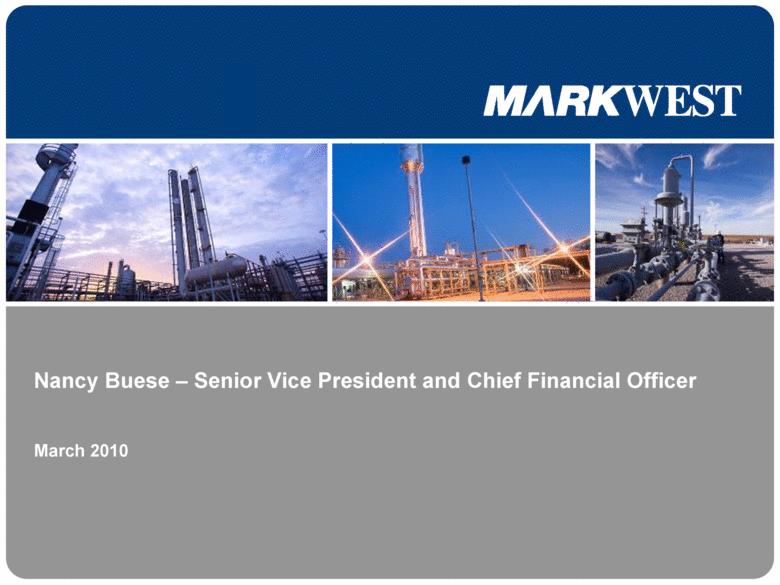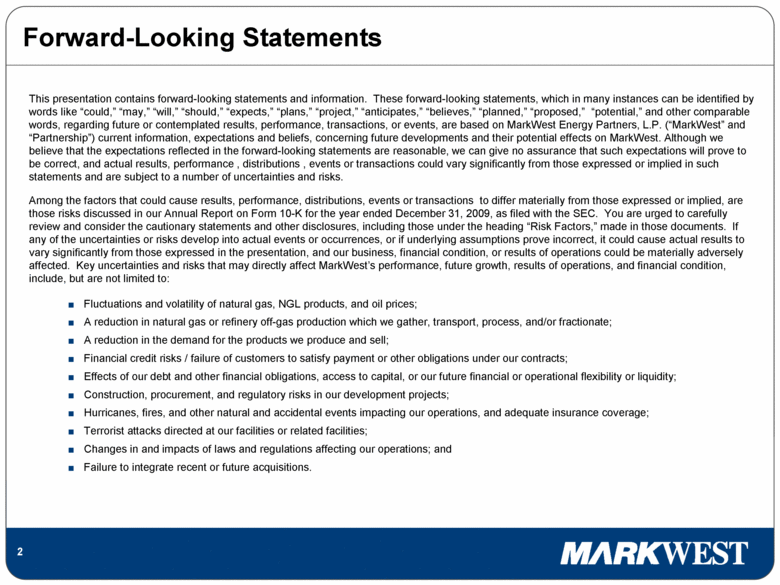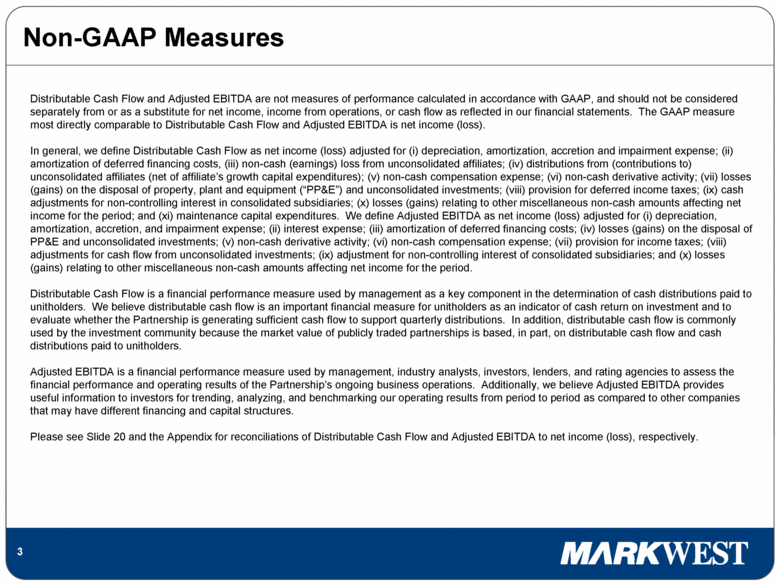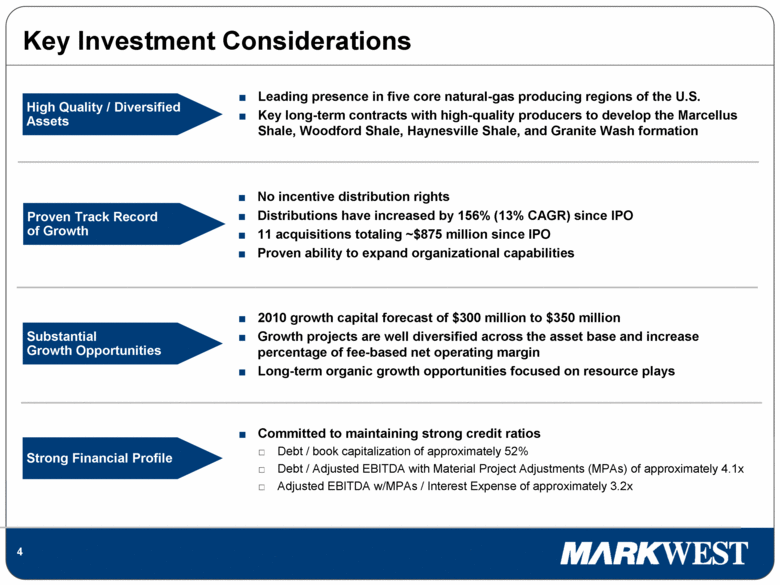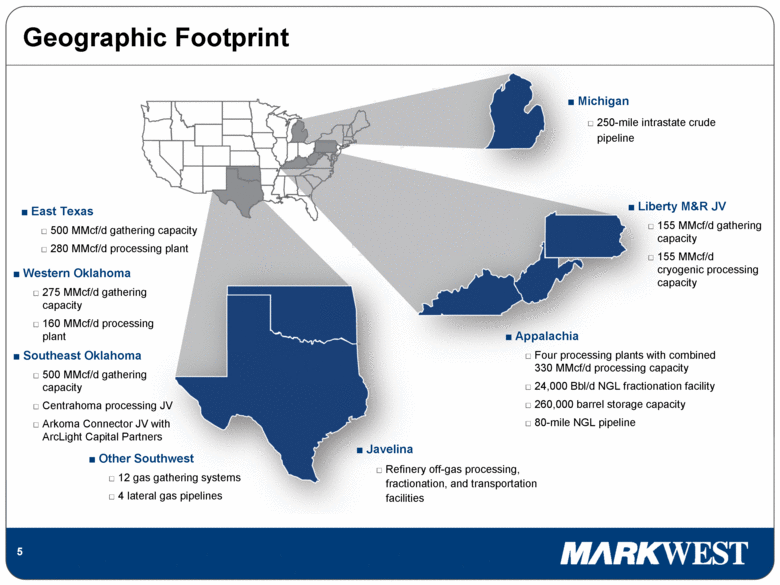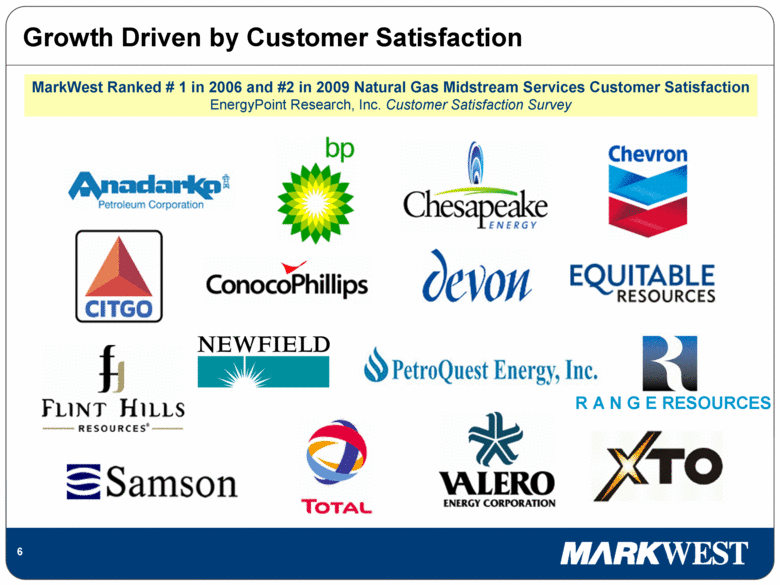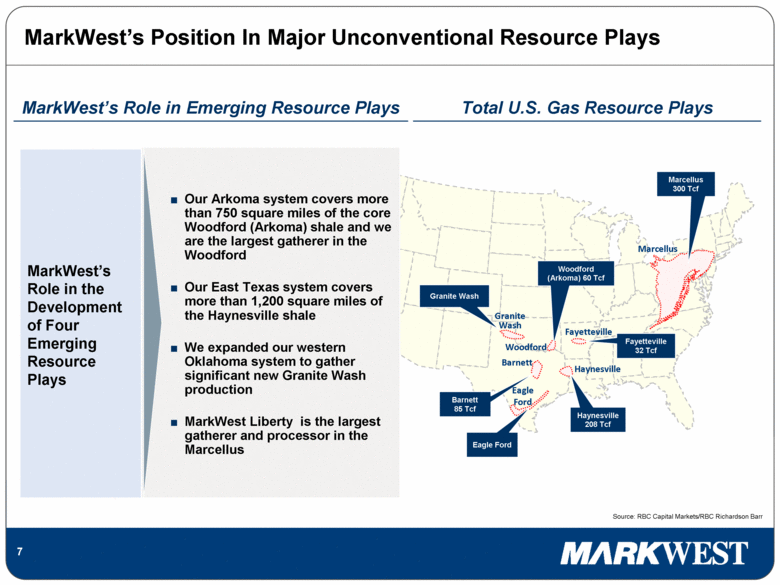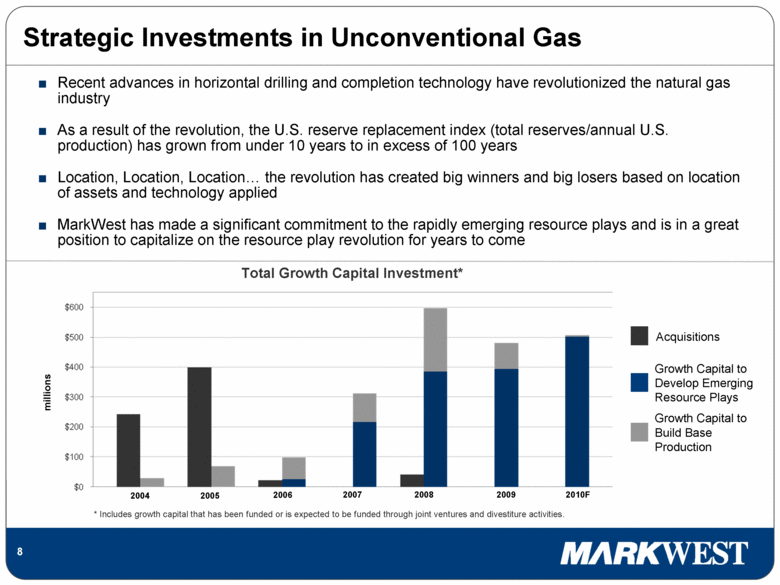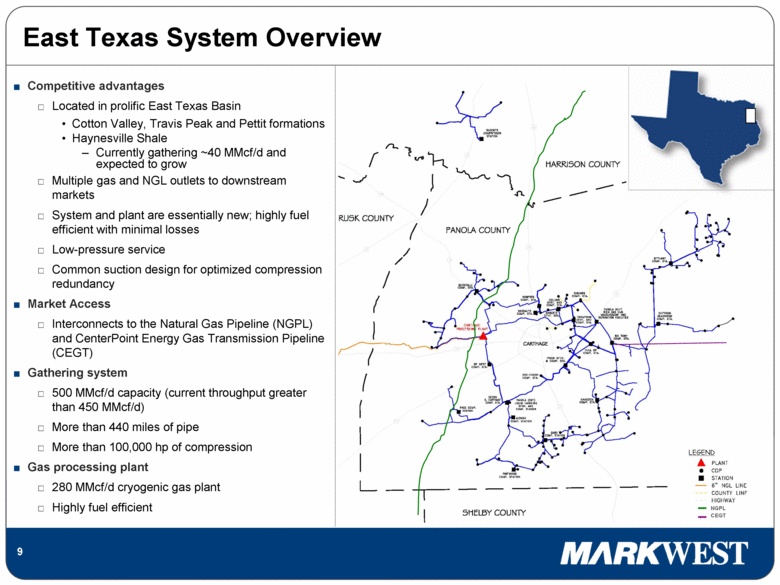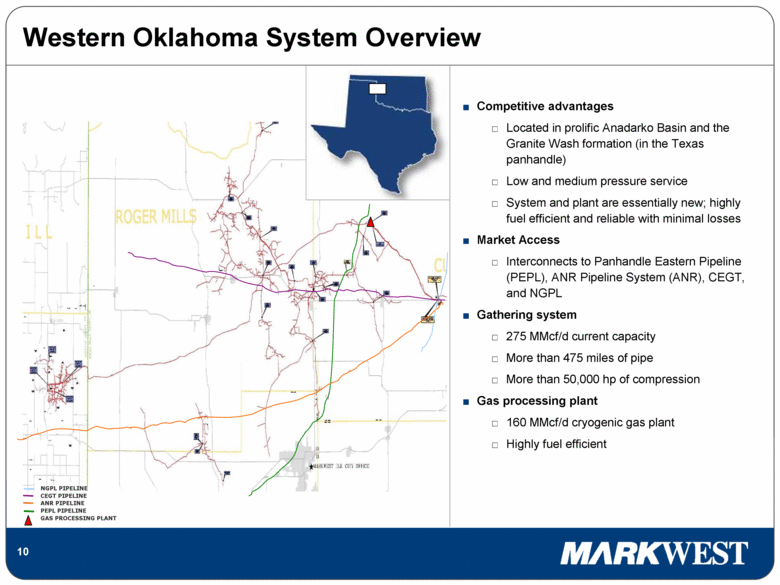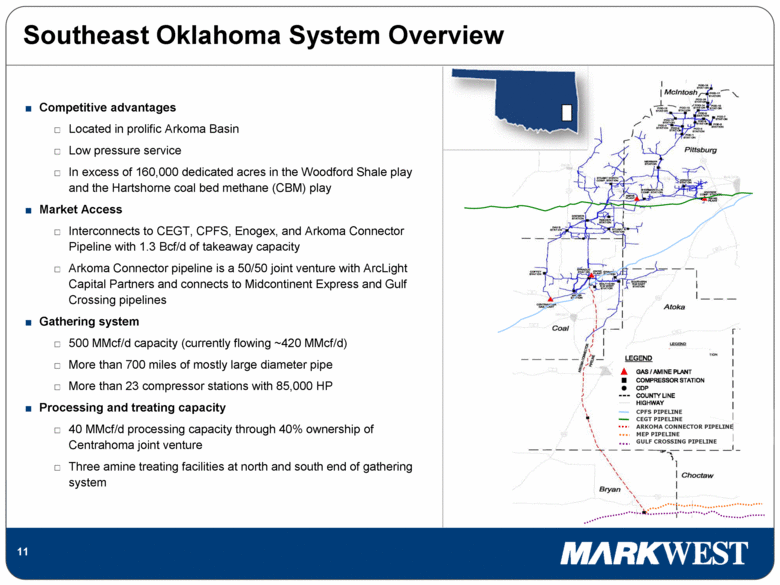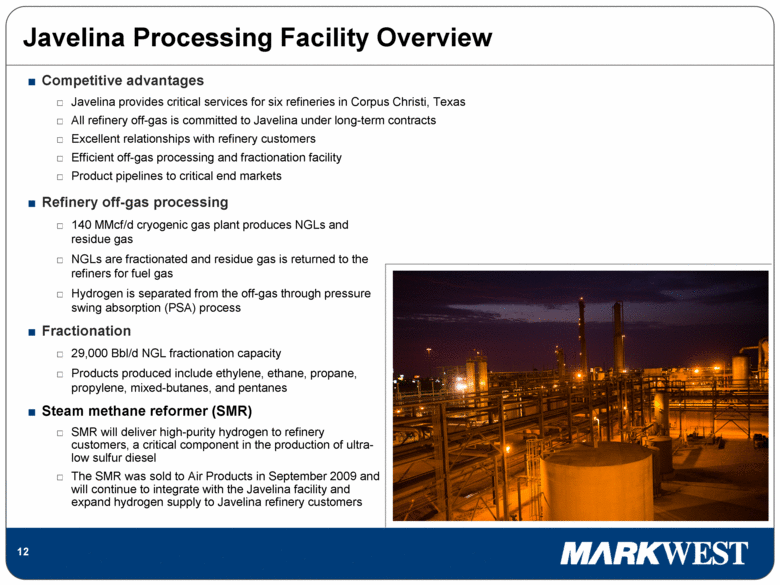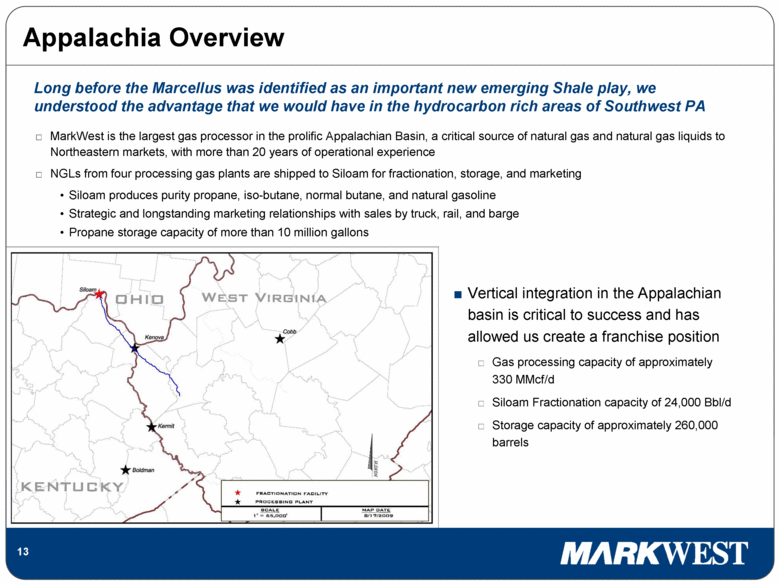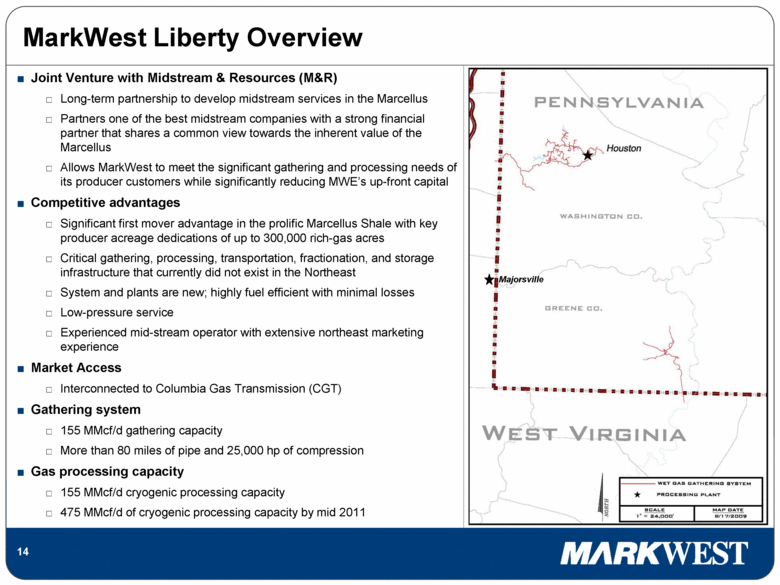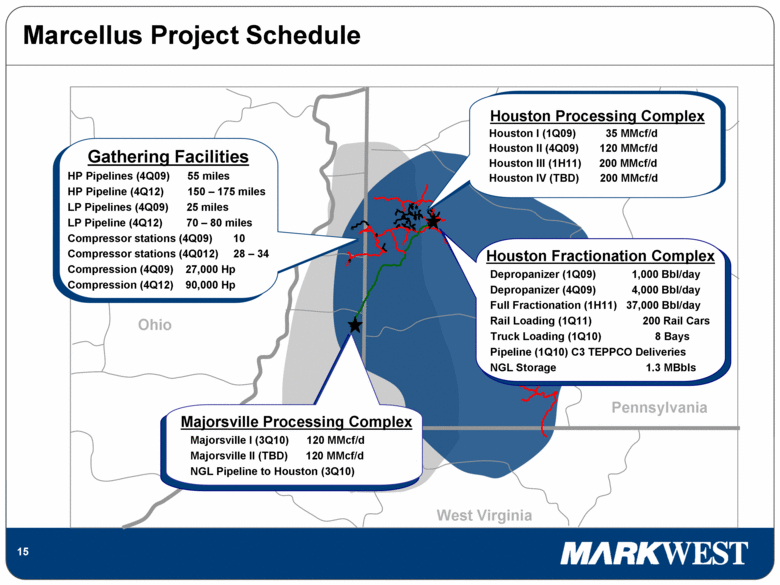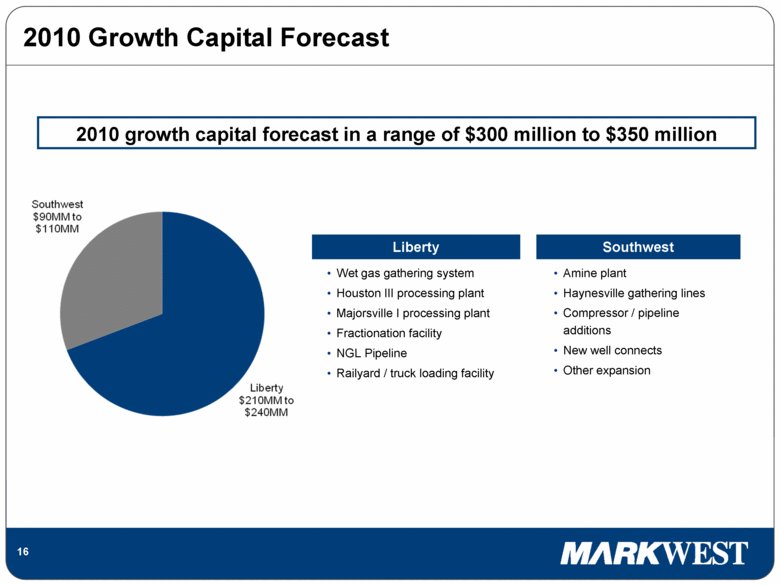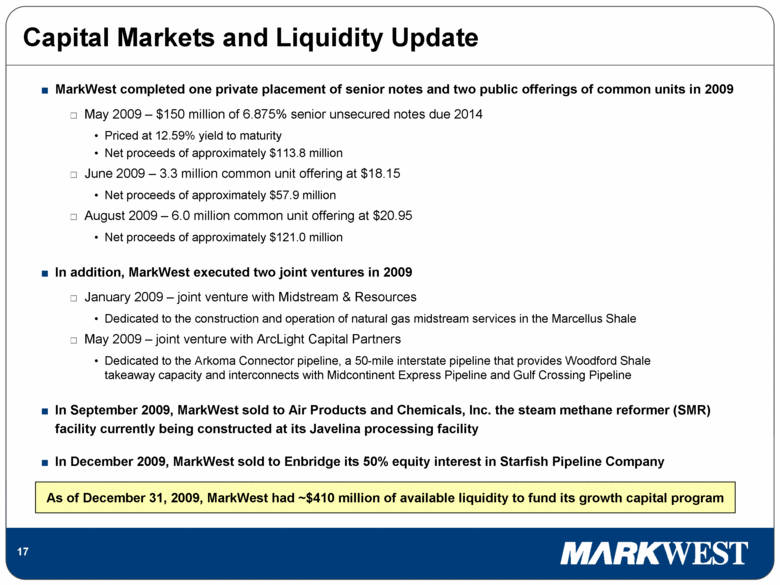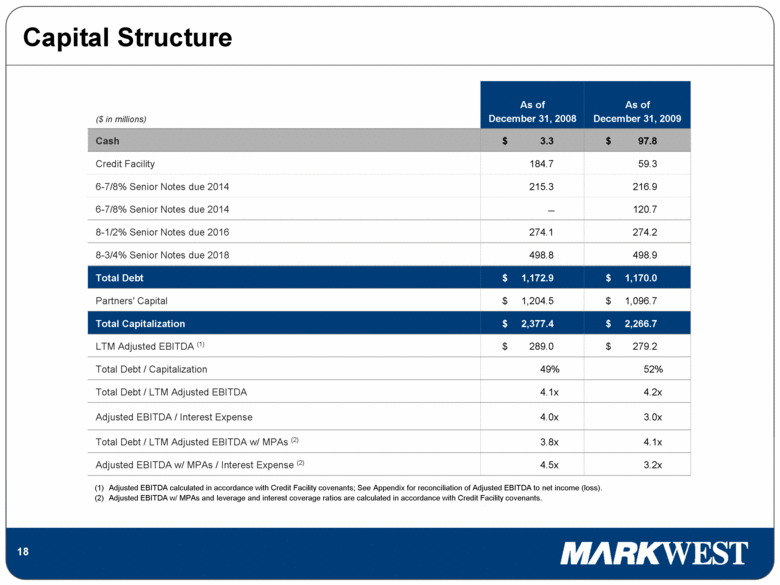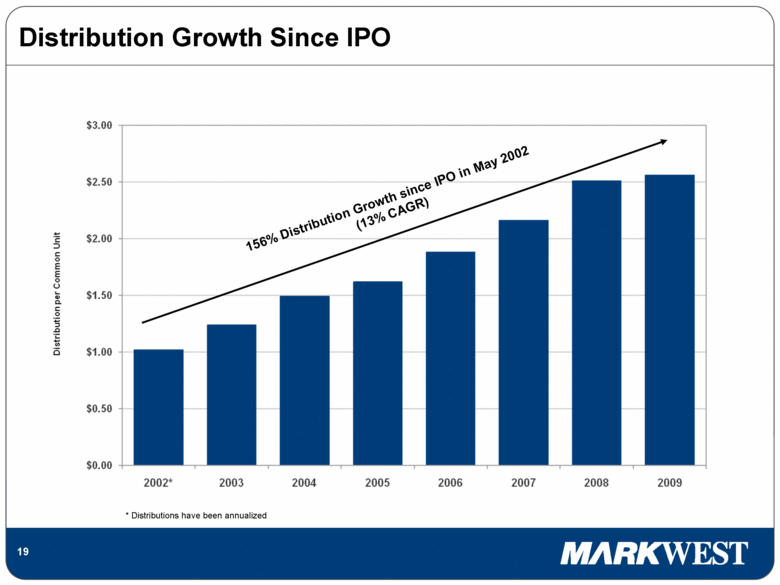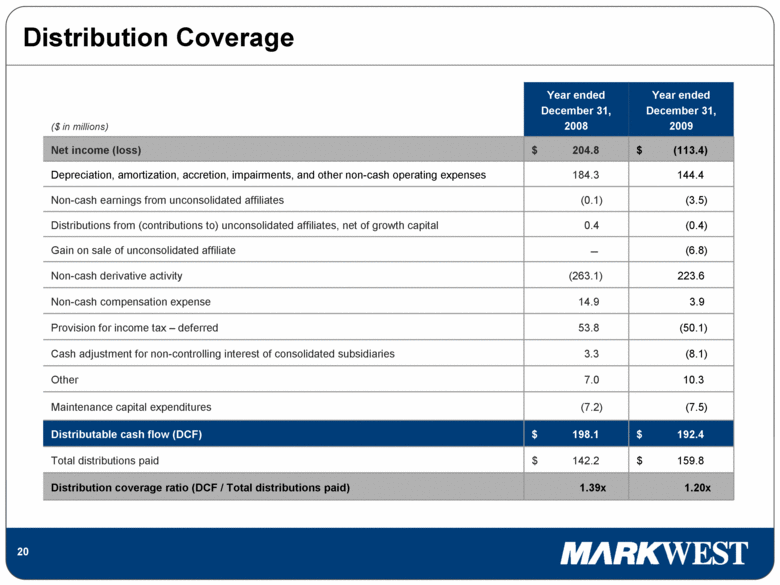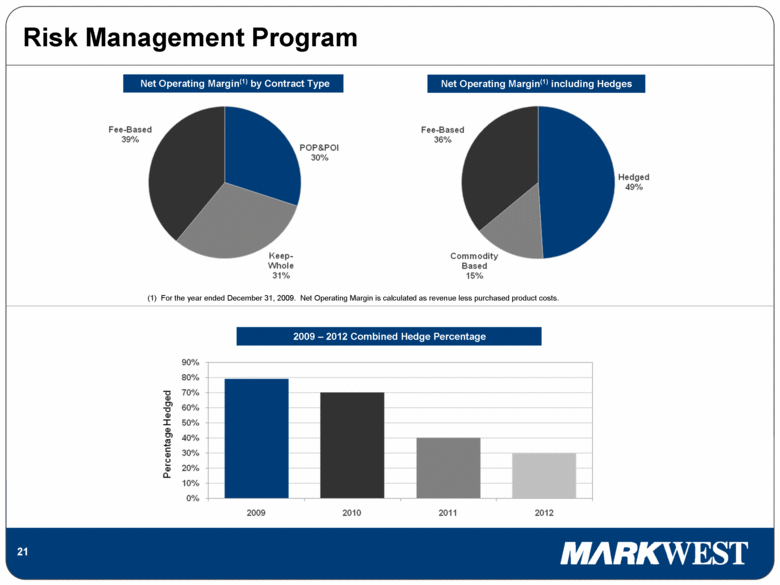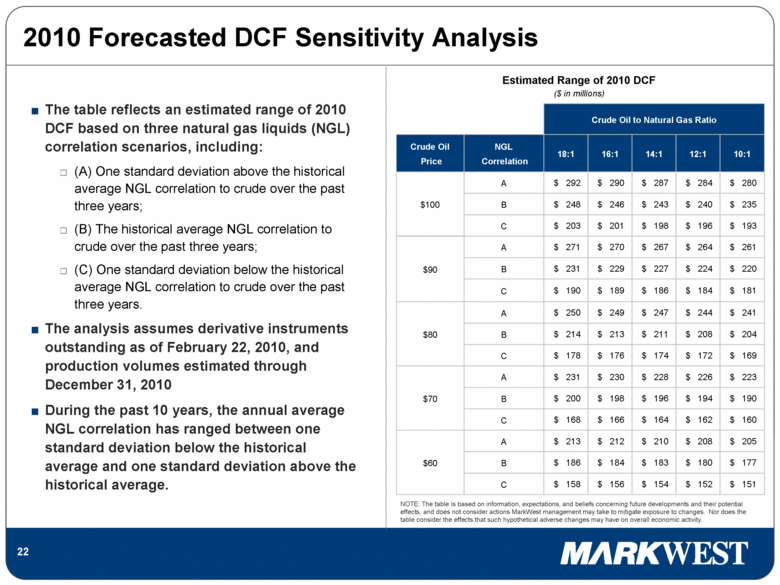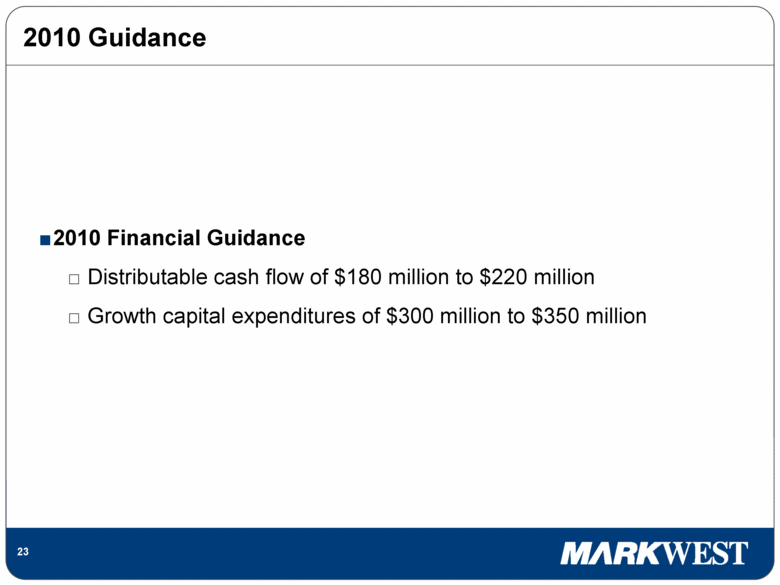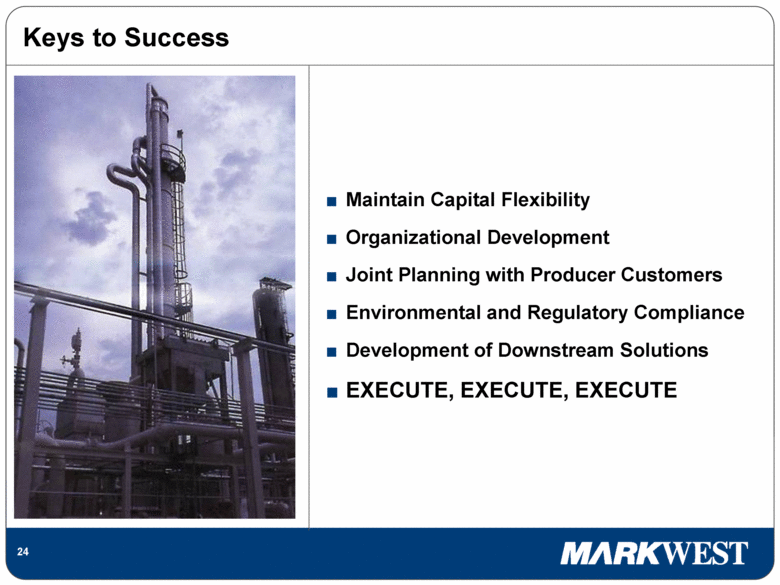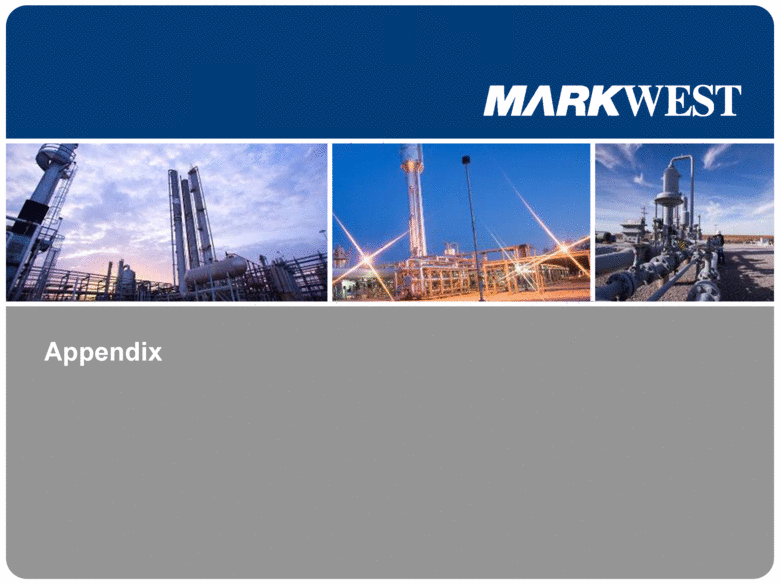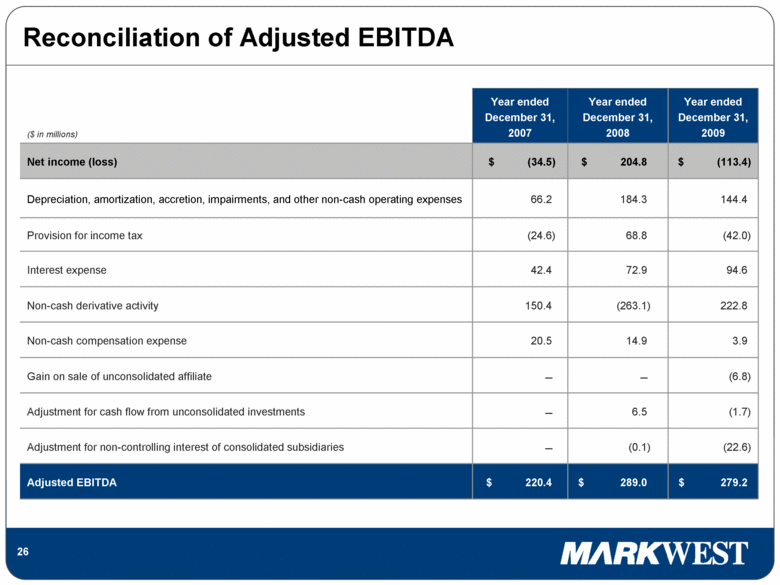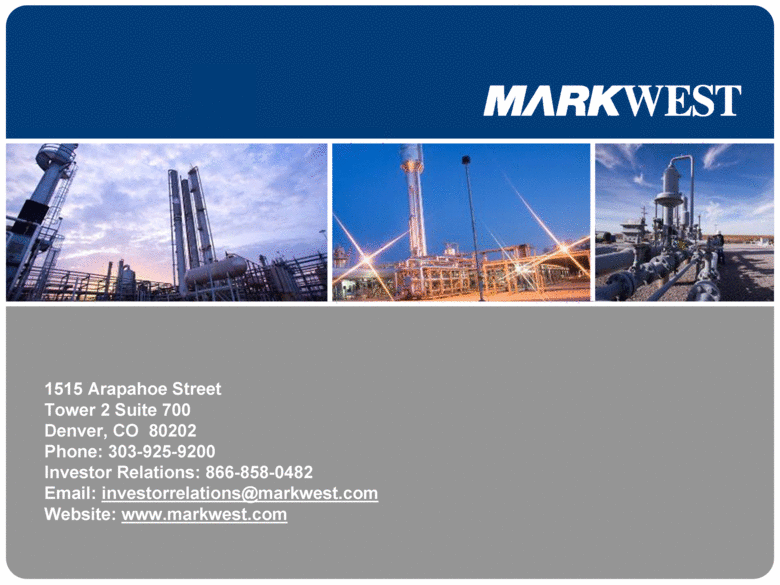Attached files
| file | filename |
|---|---|
| 8-K - 8-K - MARKWEST ENERGY PARTNERS L P | a10-6362_18k.htm |
Exhibit 99.1
|
|
Nancy Buese – Senior Vice President and Chief Financial Officer March 2010 |
|
|
Forward-Looking Statements This presentation contains forward-looking statements and information. These forward-looking statements, which in many instances can be identified by words like “could,” “may,” “will,” “should,” “expects,” “plans,” “project,” “anticipates,” “believes,” “planned,” “proposed,” “potential,” and other comparable words, regarding future or contemplated results, performance, transactions, or events, are based on MarkWest Energy Partners, L.P. (“MarkWest” and “Partnership”) current information, expectations and beliefs, concerning future developments and their potential effects on MarkWest. Although we believe that the expectations reflected in the forward-looking statements are reasonable, we can give no assurance that such expectations will prove to be correct, and actual results, performance , distributions , events or transactions could vary significantly from those expressed or implied in such statements and are subject to a number of uncertainties and risks. Among the factors that could cause results, performance, distributions, events or transactions to differ materially from those expressed or implied, are those risks discussed in our Annual Report on Form 10-K for the year ended December 31, 2009, as filed with the SEC. You are urged to carefully review and consider the cautionary statements and other disclosures, including those under the heading “Risk Factors,” made in those documents. If any of the uncertainties or risks develop into actual events or occurrences, or if underlying assumptions prove incorrect, it could cause actual results to vary significantly from those expressed in the presentation, and our business, financial condition, or results of operations could be materially adversely affected. Key uncertainties and risks that may directly affect MarkWest’s performance, future growth, results of operations, and financial condition, include, but are not limited to: Fluctuations and volatility of natural gas, NGL products, and oil prices; A reduction in natural gas or refinery off-gas production which we gather, transport, process, and/or fractionate; A reduction in the demand for the products we produce and sell; Financial credit risks / failure of customers to satisfy payment or other obligations under our contracts; Effects of our debt and other financial obligations, access to capital, or our future financial or operational flexibility or liquidity; Construction, procurement, and regulatory risks in our development projects; Hurricanes, fires, and other natural and accidental events impacting our operations, and adequate insurance coverage; Terrorist attacks directed at our facilities or related facilities; Changes in and impacts of laws and regulations affecting our operations; and Failure to integrate recent or future acquisitions. |
|
|
Non-GAAP Measures Distributable Cash Flow and Adjusted EBITDA are not measures of performance calculated in accordance with GAAP, and should not be considered separately from or as a substitute for net income, income from operations, or cash flow as reflected in our financial statements. The GAAP measure most directly comparable to Distributable Cash Flow and Adjusted EBITDA is net income (loss). In general, we define Distributable Cash Flow as net income (loss) adjusted for (i) depreciation, amortization, accretion and impairment expense; (ii) amortization of deferred financing costs, (iii) non-cash (earnings) loss from unconsolidated affiliates; (iv) distributions from (contributions to) unconsolidated affiliates (net of affiliate’s growth capital expenditures); (v) non-cash compensation expense; (vi) non-cash derivative activity; (vii) losses (gains) on the disposal of property, plant and equipment (“PP&E”) and unconsolidated investments; (viii) provision for deferred income taxes; (ix) cash adjustments for non-controlling interest in consolidated subsidiaries; (x) losses (gains) relating to other miscellaneous non-cash amounts affecting net income for the period; and (xi) maintenance capital expenditures. We define Adjusted EBITDA as net income (loss) adjusted for (i) depreciation, amortization, accretion, and impairment expense; (ii) interest expense; (iii) amortization of deferred financing costs; (iv) losses (gains) on the disposal of PP&E and unconsolidated investments; (v) non-cash derivative activity; (vi) non-cash compensation expense; (vii) provision for income taxes; (viii) adjustments for cash flow from unconsolidated investments; (ix) adjustment for non-controlling interest of consolidated subsidiaries; and (x) losses (gains) relating to other miscellaneous non-cash amounts affecting net income for the period. Distributable Cash Flow is a financial performance measure used by management as a key component in the determination of cash distributions paid to unitholders. We believe distributable cash flow is an important financial measure for unitholders as an indicator of cash return on investment and to evaluate whether the Partnership is generating sufficient cash flow to support quarterly distributions. In addition, distributable cash flow is commonly used by the investment community because the market value of publicly traded partnerships is based, in part, on distributable cash flow and cash distributions paid to unitholders. Adjusted EBITDA is a financial performance measure used by management, industry analysts, investors, lenders, and rating agencies to assess the financial performance and operating results of the Partnership’s ongoing business operations. Additionally, we believe Adjusted EBITDA provides useful information to investors for trending, analyzing, and benchmarking our operating results from period to period as compared to other companies that may have different financing and capital structures. Please see Slide 20 and the Appendix for reconciliations of Distributable Cash Flow and Adjusted EBITDA to net income (loss), respectively. |
|
|
Key Investment Considerations Committed to maintaining strong credit ratios Debt / book capitalization of approximately 52% Debt / Adjusted EBITDA with Material Project Adjustments (MPAs) of approximately 4.1x Adjusted EBITDA w/MPAs / Interest Expense of approximately 3.2x No incentive distribution rights Distributions have increased by 156% (13% CAGR) since IPO 11 acquisitions totaling ~$875 million since IPO Proven ability to expand organizational capabilities 2010 growth capital forecast of $300 million to $350 million Growth projects are well diversified across the asset base and increase percentage of fee-based net operating margin Long-term organic growth opportunities focused on resource plays High Quality / Diversified Assets Proven Track Record of Growth Strong Financial Profile Leading presence in five core natural-gas producing regions of the U.S. Key long-term contracts with high-quality producers to develop the Marcellus Shale, Woodford Shale, Haynesville Shale, and Granite Wash formation Substantial Growth Opportunities |
|
|
Geographic Footprint Michigan 250-mile intrastate crude pipeline Western Oklahoma 275 MMcf/d gathering capacity 160 MMcf/d processing plant Southeast Oklahoma 500 MMcf/d gathering capacity Centrahoma processing JV Arkoma Connector JV with ArcLight Capital Partners Appalachia Four processing plants with combined 330 MMcf/d processing capacity 24,000 Bbl/d NGL fractionation facility 260,000 barrel storage capacity 80-mile NGL pipeline Javelina Refinery off-gas processing, fractionation, and transportation facilities East Texas 500 MMcf/d gathering capacity 280 MMcf/d processing plant Other Southwest 12 gas gathering systems 4 lateral gas pipelines Liberty M&R JV 155 MMcf/d gathering capacity 155 MMcf/d cryogenic processing capacity |
|
|
Growth Driven by Customer Satisfaction R A N G E RESOURCES MarkWest Ranked # 1 in 2006 and #2 in 2009 Natural Gas Midstream Services Customer Satisfaction EnergyPoint Research, Inc. Customer Satisfaction Survey |
|
|
MarkWest’s Position In Major Unconventional Resource Plays Marcellus Barnett Haynesville Marcellus 300 Tcf Fayetteville 32 Tcf Fayetteville Woodford (Arkoma) 60 Tcf Granite Wash Barnett 85 Tcf Eagle Ford Haynesville 208 Tcf Woodford Eagle Ford Total U.S. Gas Resource Plays MarkWest’s Role in Emerging Resource Plays Source: RBC Capital Markets/RBC Richardson Barr Granite Wash Our Arkoma system covers more than 750 square miles of the core Woodford (Arkoma) shale and we are the largest gatherer in the Woodford Our East Texas system covers more than 1,200 square miles of the Haynesville shale We expanded our western Oklahoma system to gather significant new Granite Wash production MarkWest Liberty is the largest gatherer and processor in the Marcellus MarkWest’s Role in the Development of Four Emerging Resource Plays |
|
|
Strategic Investments in Unconventional Gas Acquisitions Growth Capital to Develop Emerging Resource Plays Growth Capital to Build Base Production Recent advances in horizontal drilling and completion technology have revolutionized the natural gas industry As a result of the revolution, the U.S. reserve replacement index (total reserves/annual U.S. production) has grown from under 10 years to in excess of 100 years Location, Location, Location the revolution has created big winners and big losers based on location of assets and technology applied MarkWest has made a significant commitment to the rapidly emerging resource plays and is in a great position to capitalize on the resource play revolution for years to come Total Growth Capital Investment* millions * Includes growth capital that has been funded or is expected to be funded through joint ventures and divestiture activities. 2004 2005 2006 2007 2008 2009 2010F |
|
|
Competitive advantages Located in prolific East Texas Basin Cotton Valley, Travis Peak and Pettit formations Haynesville Shale Currently gathering ~40 MMcf/d and expected to grow Multiple gas and NGL outlets to downstream markets System and plant are essentially new; highly fuel efficient with minimal losses Low-pressure service Common suction design for optimized compression redundancy Market Access Interconnects to the Natural Gas Pipeline (NGPL) and CenterPoint Energy Gas Transmission Pipeline (CEGT) Gathering system 500 MMcf/d capacity (current throughput greater than 450 MMcf/d) More than 440 miles of pipe More than 100,000 hp of compression Gas processing plant 280 MMcf/d cryogenic gas plant Highly fuel efficient East Texas System Overview LEGEND NGPL CEGT |
|
|
Competitive advantages Located in prolific Anadarko Basin and the Granite Wash formation (in the Texas panhandle) Low and medium pressure service System and plant are essentially new; highly fuel efficient and reliable with minimal losses Market Access Interconnects to Panhandle Eastern Pipeline (PEPL), ANR Pipeline System (ANR), CEGT, and NGPL Gathering system 275 MMcf/d current capacity More than 475 miles of pipe More than 50,000 hp of compression Gas processing plant 160 MMcf/d cryogenic gas plant Highly fuel efficient Western Oklahoma System Overview NGPL PIPELINE CEGT PIPELINE ANR PIPELINE PEPL PIPELINE GAS PROCESSING PLANT |
|
|
Competitive advantages Located in prolific Arkoma Basin Low pressure service In excess of 160,000 dedicated acres in the Woodford Shale play and the Hartshorne coal bed methane (CBM) play Market Access Interconnects to CEGT, CPFS, Enogex, and Arkoma Connector Pipeline with 1.3 Bcf/d of takeaway capacity Arkoma Connector pipeline is a 50/50 joint venture with ArcLight Capital Partners and connects to Midcontinent Express and Gulf Crossing pipelines Gathering system 500 MMcf/d capacity (currently flowing ~420 MMcf/d) More than 700 miles of mostly large diameter pipe More than 23 compressor stations with 85,000 HP Processing and treating capacity 40 MMcf/d processing capacity through 40% ownership of Centrahoma joint venture Three amine treating facilities at north and south end of gathering system Southeast Oklahoma System Overview CPFS PIPELINE CEGT PIPELINE ARKOMA CONNECTOR PIPELINE MEP PIPELINE GULF CROSSING PIPELINE |
|
|
Refinery off-gas processing 140 MMcf/d cryogenic gas plant produces NGLs and residue gas NGLs are fractionated and residue gas is returned to the refiners for fuel gas Hydrogen is separated from the off-gas through pressure swing absorption (PSA) process Fractionation 29,000 Bbl/d NGL fractionation capacity Products produced include ethylene, ethane, propane, propylene, mixed-butanes, and pentanes Steam methane reformer (SMR) SMR will deliver high-purity hydrogen to refinery customers, a critical component in the production of ultra-low sulfur diesel The SMR was sold to Air Products in September 2009 and will continue to integrate with the Javelina facility and expand hydrogen supply to Javelina refinery customers Javelina Processing Facility Overview Competitive advantages Javelina provides critical services for six refineries in Corpus Christi, Texas All refinery off-gas is committed to Javelina under long-term contracts Excellent relationships with refinery customers Efficient off-gas processing and fractionation facility Product pipelines to critical end markets |
|
|
Appalachia Overview MarkWest is the largest gas processor in the prolific Appalachian Basin, a critical source of natural gas and natural gas liquids to Northeastern markets, with more than 20 years of operational experience NGLs from four processing gas plants are shipped to Siloam for fractionation, storage, and marketing Siloam produces purity propane, iso-butane, normal butane, and natural gasoline Strategic and longstanding marketing relationships with sales by truck, rail, and barge Propane storage capacity of more than 10 million gallons Long before the Marcellus was identified as an important new emerging Shale play, we understood the advantage that we would have in the hydrocarbon rich areas of Southwest PA Vertical integration in the Appalachian basin is critical to success and has allowed us create a franchise position Gas processing capacity of approximately 330 MMcf/d Siloam Fractionation capacity of 24,000 Bbl/d Storage capacity of approximately 260,000 barrels |
|
|
MarkWest Liberty Overview Joint Venture with Midstream & Resources (M&R) Long-term partnership to develop midstream services in the Marcellus Partners one of the best midstream companies with a strong financial partner that shares a common view towards the inherent value of the Marcellus Allows MarkWest to meet the significant gathering and processing needs of its producer customers while significantly reducing MWE’s up-front capital Competitive advantages Significant first mover advantage in the prolific Marcellus Shale with key producer acreage dedications of up to 300,000 rich-gas acres Critical gathering, processing, transportation, fractionation, and storage infrastructure that currently did not exist in the Northeast System and plants are new; highly fuel efficient with minimal losses Low-pressure service Experienced mid-stream operator with extensive northeast marketing experience Market Access Interconnected to Columbia Gas Transmission (CGT) Gathering system 155 MMcf/d gathering capacity More than 80 miles of pipe and 25,000 hp of compression Gas processing capacity 155 MMcf/d cryogenic processing capacity 475 MMcf/d of cryogenic processing capacity by mid 2011 Majorsville |
|
|
Marcellus Project Schedule Ohio West Virginia Majorsville Processing Complex Majorsville I (3Q10) 120 MMcf/d Majorsville II (TBD) 120 MMcf/d NGL Pipeline to Houston (3Q10) Houston Processing Complex Houston I (1Q09) 35 MMcf/d Houston II (4Q09) 120 MMcf/d Houston III (1H11) 200 MMcf/d Houston IV (TBD) 200 MMcf/d Houston Fractionation Complex Depropanizer (1Q09) 1,000 Bbl/day Depropanizer (4Q09) 4,000 Bbl/day Full Fractionation (1H11) 37,000 Bbl/day Rail Loading (1Q11) 200 Rail Cars Truck Loading (1Q10) 8 Bays Pipeline (1Q10) C3 TEPPCO Deliveries NGL Storage 1.3 MBbls Gathering Facilities HP Pipelines (4Q09) 55 miles HP Pipeline (4Q12) 150 – 175 miles LP Pipelines (4Q09) 25 miles LP Pipeline (4Q12) 70 – 80 miles Compressor stations (4Q09) 10 Compressor stations (4Q012) 28 – 34 Compression (4Q09) 27,000 Hp Compression (4Q12) 90,000 Hp Pennsylvania |
|
|
2010 Growth Capital Forecast 2010 growth capital forecast in a range of $300 million to $350 million Southwest Amine plant Haynesville gathering lines Compressor / pipeline additions New well connects Other expansion Liberty Wet gas gathering system Houston III processing plant Majorsville I processing plant Fractionation facility NGL Pipeline Railyard / truck loading facility |
|
|
As of December 31, 2009, MarkWest had ~$410 million of available liquidity to fund its growth capital program MarkWest completed one private placement of senior notes and two public offerings of common units in 2009 May 2009 – $150 million of 6.875% senior unsecured notes due 2014 Priced at 12.59% yield to maturity Net proceeds of approximately $113.8 million June 2009 – 3.3 million common unit offering at $18.15 Net proceeds of approximately $57.9 million August 2009 – 6.0 million common unit offering at $20.95 Net proceeds of approximately $121.0 million In addition, MarkWest executed two joint ventures in 2009 January 2009 – joint venture with Midstream & Resources Dedicated to the construction and operation of natural gas midstream services in the Marcellus Shale May 2009 – joint venture with ArcLight Capital Partners Dedicated to the Arkoma Connector pipeline, a 50-mile interstate pipeline that provides Woodford Shale takeaway capacity and interconnects with Midcontinent Express Pipeline and Gulf Crossing Pipeline In September 2009, MarkWest sold to Air Products and Chemicals, Inc. the steam methane reformer (SMR) facility currently being constructed at its Javelina processing facility In December 2009, MarkWest sold to Enbridge its 50% equity interest in Starfish Pipeline Company Capital Markets and Liquidity Update |
|
|
Capital Structure ($ in millions) As of December 31, 2008 As of December 31, 2009 Cash $ 3.3 $ 97.8 Credit Facility 184.7 59.3 6-7/8% Senior Notes due 2014 215.3 216.9 6-7/8% Senior Notes due 2014 120.7 8-1/2% Senior Notes due 2016 274.1 274.2 8-3/4% Senior Notes due 2018 498.8 498.9 Total Debt $ 1,172.9 $ 1,170.0 Partners' Capital $ 1,204.5 $ 1,096.7 Total Capitalization $ 2,377.4 $ 2,266.7 LTM Adjusted EBITDA (1) $ 289.0 $ 279.2 Total Debt / Capitalization 49% 52% Total Debt / LTM Adjusted EBITDA 4.1x 4.2x Adjusted EBITDA / Interest Expense 4.0x 3.0x Total Debt / LTM Adjusted EBITDA w/ MPAs (2) 3.8x 4.1x Adjusted EBITDA w/ MPAs / Interest Expense (2) 4.5x 3.2x Adjusted EBITDA calculated in accordance with Credit Facility covenants; See Appendix for reconciliation of Adjusted EBITDA to net income (loss). Adjusted EBITDA w/ MPAs and leverage and interest coverage ratios are calculated in accordance with Credit Facility covenants. |
|
|
Distribution Growth Since IPO 156% Distribution Growth since IPO in May 2002 (13% CAGR) * Distributions have been annualized |
|
|
($ in millions) Year ended December 31, 2008 Year ended December 31, 2009 Net income (loss) $ 204.8 $ (113.4) Depreciation, amortization, accretion, impairments, and other non-cash operating expenses 184.3 144.4 Non-cash earnings from unconsolidated affiliates (0.1) (3.5) Distributions from (contributions to) unconsolidated affiliates, net of growth capital 0.4 (0.4) Gain on sale of unconsolidated affiliate (6.8) Non-cash derivative activity (263.1) 223.6 Non-cash compensation expense 14.9 3.9 Provision for income tax – deferred 53.8 (50.1) Cash adjustment for non-controlling interest of consolidated subsidiaries 3.3 (8.1) Other 7.0 10.3 Maintenance capital expenditures (7.2) (7.5) Distributable cash flow (DCF) $ 198.1 $ 192.4 Total distributions paid $ 142.2 $ 159.8 Distribution coverage ratio (DCF / Total distributions paid) 1.39x 1.20x Distribution Coverage |
|
|
Risk Management Program Net Operating Margin(1) by Contract Type Net Operating Margin(1) including Hedges 2009 – 2012 Combined Hedge Percentage (1) For the year ended December 31, 2009. Net Operating Margin is calculated as revenue less purchased product costs. |
|
|
2010 Forecasted DCF Sensitivity Analysis Crude Oil to Natural Gas Ratio Crude Oil Price NGL Correlation 18:1 16:1 14:1 12:1 10:1 $100 A $ 292 $ 290 $ 287 $ 284 $ 280 B $ 248 $ 246 $ 243 $ 240 $ 235 C $ 203 $ 201 $ 198 $ 196 $ 193 $90 A $ 271 $ 270 $ 267 $ 264 $ 261 B $ 231 $ 229 $ 227 $ 224 $ 220 C $ 190 $ 189 $ 186 $ 184 $ 181 $80 A $ 250 $ 249 $ 247 $ 244 $ 241 B $ 214 $ 213 $ 211 $ 208 $ 204 C $ 178 $ 176 $ 174 $ 172 $ 169 $70 A $ 231 $ 230 $ 228 $ 226 $ 223 B $ 200 $ 198 $ 196 $ 194 $ 190 C $ 168 $ 166 $ 164 $ 162 $ 160 $60 A $ 213 $ 212 $ 210 $ 208 $ 205 B $ 186 $ 184 $ 183 $ 180 $ 177 C $ 158 $ 156 $ 154 $ 152 $ 151 NOTE: The table is based on information, expectations, and beliefs concerning future developments and their potential effects, and does not consider actions MarkWest management may take to mitigate exposure to changes. Nor does the table consider the effects that such hypothetical adverse changes may have on overall economic activity. Estimated Range of 2010 DCF ($ in millions) The table reflects an estimated range of 2010 DCF based on three natural gas liquids (NGL) correlation scenarios, including: (A) One standard deviation above the historical average NGL correlation to crude over the past three years; (B) The historical average NGL correlation to crude over the past three years; (C) One standard deviation below the historical average NGL correlation to crude over the past three years. The analysis assumes derivative instruments outstanding as of February 22, 2010, and production volumes estimated through December 31, 2010 During the past 10 years, the annual average NGL correlation has ranged between one standard deviation below the historical average and one standard deviation above the historical average. |
|
|
2010 Guidance 2010 Financial Guidance Distributable cash flow of $180 million to $220 million Growth capital expenditures of $300 million to $350 million |
|
|
Keys to Success Maintain Capital Flexibility Organizational Development Joint Planning with Producer Customers Environmental and Regulatory Compliance Development of Downstream Solutions EXECUTE, EXECUTE, EXECUTE |
|
|
Appendix |
|
|
($ in millions) Year ended December 31, 2007 Year ended December 31, 2008 Year ended December 31, 2009 Net income (loss) $ (34.5) $ 204.8 $ (113.4) Depreciation, amortization, accretion, impairments, and other non-cash operating expenses 66.2 184.3 144.4 Provision for income tax (24.6) 68.8 (42.0) Interest expense 42.4 72.9 94.6 Non-cash derivative activity 150.4 (263.1) 222.8 Non-cash compensation expense 20.5 14.9 3.9 Gain on sale of unconsolidated affiliate (6.8) Adjustment for cash flow from unconsolidated investments 6.5 (1.7) Adjustment for non-controlling interest of consolidated subsidiaries (0.1) (22.6) Adjusted EBITDA $ 220.4 $ 289.0 $ 279.2 Reconciliation of Adjusted EBITDA |
|
|
1515 Arapahoe Street Tower 2 Suite 700 Denver, CO 80202 Phone: 303-925-9200 Investor Relations: 866-858-0482 Email: investorrelations@markwest.com Website: www.markwest.com |

